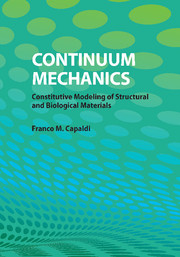9 - Growth Models
Published online by Cambridge University Press: 05 August 2012
Summary
In this chapter, we introduce the use of internal variables. Specifically, we will consider a thermo-mechanical solid, which grows in response to the stress state within the material. This could be used as a simple model for growing or remodeling biological tissue. Internal variables can be used to capture a wide range of phenomena such as material damage, plasticity, and crystallinity. This chapter is meant to illustrate the use of an internal variable and the numerical methods used to implement such a model. The internal variable in the model outlined in this chapter is used to account for the amount of growth within the material. A simple evolution equation that couples the internal variable representing growth to the stress state of the material is written. The formulation of this model is significantly different from the previous models in that mass may be introduced or removed from the system. As mass is removed at any given point within the system, the momentum and energy associated with that mass is also removed. In effect, the mass instantaneously disappears. When mass is added at a given point, it is introduced with the same velocity, temperature, and energy of the mass that currently occupies the point.
Forces and Fields
In this chapter, we consider a thermo-mechanical solid model, which includes an internal variable accounting for the growth of the solid. Growth is captured in this model by introducing the rate of mass change per unit volume, ɸg (x, t).
- Type
- Chapter
- Information
- Continuum MechanicsConstitutive Modeling of Structural and Biological Materials, pp. 244 - 257Publisher: Cambridge University PressPrint publication year: 2012



